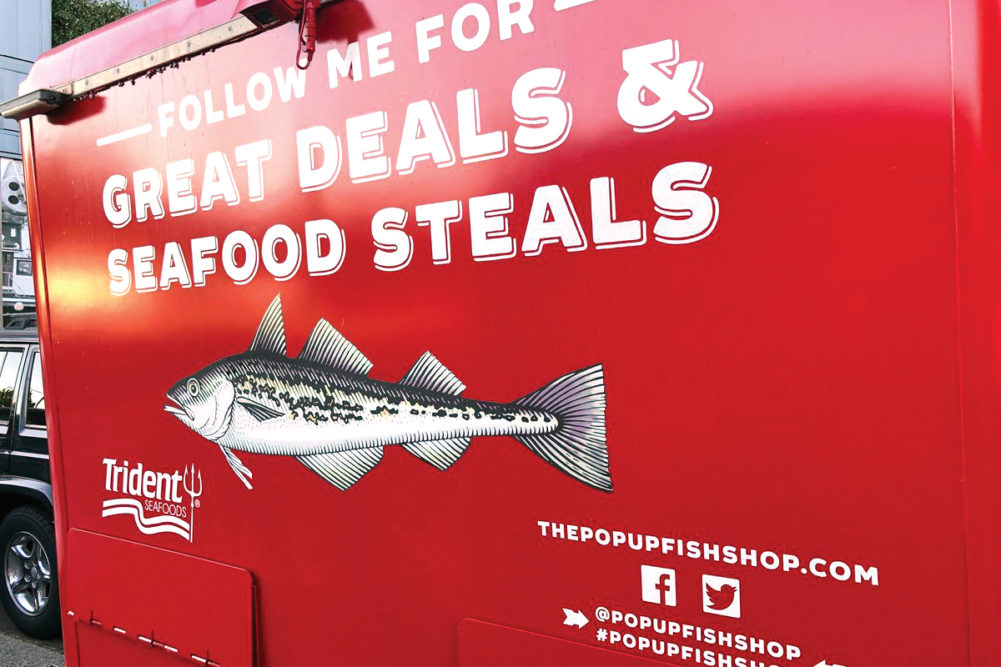KANSAS CITY, MO. - The right merchandising can make all the difference when it comes to selling fresh seafood. Service case vs. self-serve is just the beginning.
Bensenville, Ill.-based Fortune Fish & Gourmet has in-house merchandisers that visit stores regularly and support many of the company’s customers at store level and suggest proper merchandising, said Stacy Schultz, Fortune’s director of marketing and sustainability coordinator.
Not all customers ask for the service, however. Some Other have their own plan and know the best way to merchandise their stores based on sales data, Schultz said.
When it comes to best practices for packaged seafood, one key is sufficient brand exposure.
“More than one SKU is suggested, so the brand is well represented,” Schultz said.
For seafood sold from the fresh counter, Fortune recommends color flow in the case and a variety of fresh fish and shellfish that includes seasonal items. And remember to separate the shellfish from the finfish.
Packaging also plays a crucial role in the effective merchandising of seafood in the retail perimeter, Schultz said.
“Packaging can tell the story of the product, along with promoting clean ingredients and sustainable sourcing. Web links or QR codes on the packaging can be added to the packaging to provide recipes.”
Another key to good merchandising: don’t cut corners.
“Some retailers look to cut cost and offer subpar product in order to hit margin, but they don’t realize that they’re not locking in long-term repeat business when the consumer doesn’t have great experience with it at home.”
Fortune also recommends customers buy whole fish and cut it inhouse, if possible — pre-cut fish can have a shorter shelf life.
Fortune’s mix of service-case and self-serve is about half and half, Schultz said. But there’s no mistaking which way the industry is trending.
“Self-serve is obviously on the rise due to Covid-19,” she said. “Self-serve reduces the need for counter staff and handling of the seafood.”
Merchandising tips from Harvest Food Distributors:
1. Keep it colorful. Alternating fish species by color will create an eye-catching display. For example, display tilapia fillets next to salmon, then cod fillets. Don’t put three white fish next to each other. You can also shake it up by intermingling fish species. For example, lobster next to fillets, next to shrimp, and so on. Another way to pump up the color is to use fruits and vegetables in your display to give bright pops of color. Use lemons, blood oranges, red onions, parsley, and kale to separate species or divide a row that has two kinds of seafood.
2. Variety is the spice of life. If you have tilapia fillets next to mahi mahi fillets, display one fillet vertically and the other one horizontally to add more variety to your seafood case display. Varying the height of different items can also add variety to seafood display. Get creative, break some rules and have fun, but also be sure not to cross contaminate, putting raw product next to cooked.
3. Light it. Better visibility will accentuate the rich colors of seafood rather than detract from it. Definitely consider investing in LED lighting, which offers direct light beams that focus on the product and have a dramatic impact on your seafood merchandising. Although LED display case lights cost more initially, they will save you money in the long run since they use 25%–30% of the energy and last 8 to 25 times longer than halogen incandescent lights.
4. Keep if fresh. Pay attention to peak shopping times and freshen the product before your lunchtime and after work rush hours. In the morning you may want to only set up one or two deep, and then before your busy times, add more to your seafood display. Don’t just load it up in the morning and leave it unattended to dry out all day. Fillets and steaks should have firm, elastic flesh and a fresh-cut, moist appearance, with no browning around the edges. Whole fish should have bright, clear, full eyes that are often protruding and bright red or pink gills.
No contact
Trident Seafoods Corp. has come up with an innovative approach to retail seafood merchandising. The Seattle-based company was so inspired by the curbside pickup strategies of many local restaurants, it came up with its own.
"We’ve turned our Pop Up Fish Shop seafood truck into a mobile, No Contact Drive-Thru Seafood Shopping experience," according to the company. "Now you can buy delicious, nutritious and affordable seafood while keeping a safe social distance. Just order and pre-pay online, then drive up and pick up at the No Contact Drive-Thru."
Merchandisers: think healthy and sustainable…
- 82% of seafood customers put at least some if not a lot of effort into choosing nutritious and healthy seafood options
- 64% of seafood consumers put some or a lot of effort into selecting sustainable seafood items
- …and start getting the word out about Fair Trade:
- 35% of seafood consumers are familiar with Fair Trade certified seafood.
Source: FMI’s 2019 Power of Seafood report.
This story is from the July 2020 issue of Supermarket Perimeter. To view the full magazine, click here.

